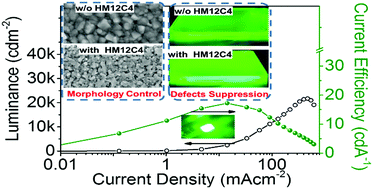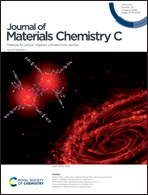Synergistic morphology control and non-radiative defect passivation using a crown ether for efficient perovskite light-emitting devices†
Abstract
Controlling the nucleation process and forming small nanograins, as well as passivating defects at grain boundaries as the grain size becomes smaller, in one-step solution formed polycrystalline halide perovskites are of great importance for achieving efficient perovskite light-emitting diodes (PeLEDs). Here, a crown ether, 2-hydroxymethyl-12-crown-4 (HM12C4), is adopted as an additive and its influence on the photophysical and electroluminescent properties of a PeLED was investigated. It is found that HM12C4 can not only suppress PbBr6 octahedron agglomeration in the precursor but also improve the wettability of the hole transport layer, resulting in a smoother dense perovskite film with smaller polycrystallites. Moreover, the retained HM12C4 in the perovskite film effectively passivated the defects at the grain boundaries and improved the photophysical and electroluminescent properties. Consequently, significantly enhanced electroluminescent performance was achieved with a low turn-on voltage of 2.3 V, a current efficiency of 17.2 cd A−1, and an external quantum efficiency of 4.52%. Our findings reveal that crown ethers have great potential in exploiting high-performance PeLED, with significant implications for the further development of PeLEDs.



 Please wait while we load your content...
Please wait while we load your content...